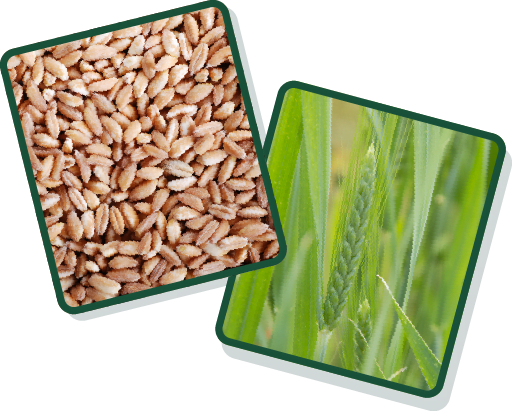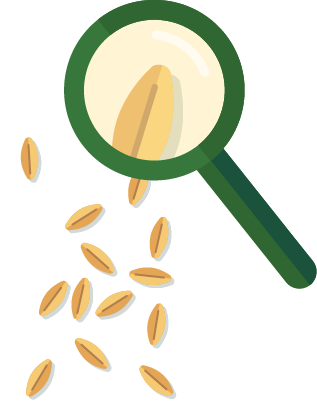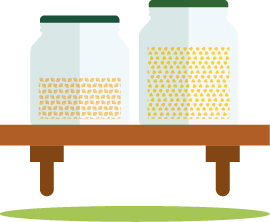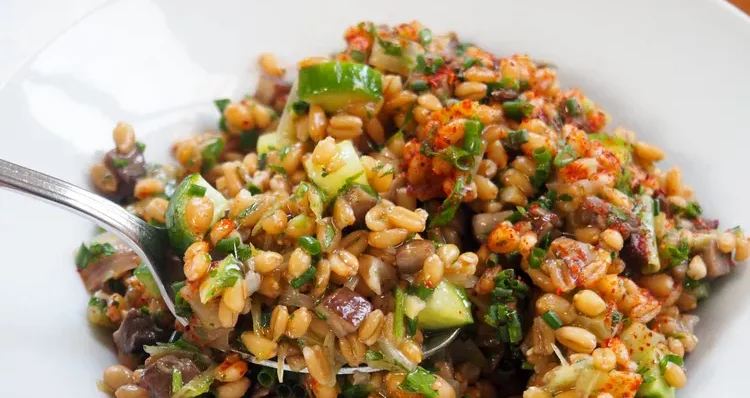Wheat encompasses a variety of grains that fall under the wheat family, including “common” wheat (used in most breads and flours) as well as ancient wheat varieties such as einkorn, farro, emmer, and spelt. These ancient grains are early forms of wheat that were cultivated for centuries—and in some cases, millennia—before the development of modern wheat varieties. Unlike today’s common wheat, which has been selectively bred for higher yields and ease of processing, these ancient varieties have remained largely unchanged and are valued for their distinct flavours, higher nutrient density, and adaptability to different growing conditions.
These grains share a robust, earthy flavour and a chewy texture when cooked. They originated in regions such as the Fertile Crescent (modern-day Middle East) and were integral to the diets of early agricultural civilisations, forming the backbone of many traditional diets.

Nutritionally, whole wheat bread is high in fibre and is a source of magnesium, phosphorus, and copper.
Wheat contains gluten, so it is not suitable for those with gluten intolerance or coeliac disease.

Toggle with the tables below to compare their nutritional content per 100 g (both cooked and uncooked) and per average portion size. You might be surprised by the differences!
| Grains | Kcal | Protein | Fat | Saturated fat | Carbohydrates | Fibre |
|---|---|---|---|---|---|---|
| Pearl barley, Per 100 g, cooked | 123.00 | 2 | 0 | 0 | 28 | 3 |
| Pearl barley, Per 100 g, uncooked | 352.00 | 9 | 1 | 0 | 77 | 15 |
| Whole grain barley, Per 100 g, uncooked | 354.00 | 12 | 2 | 0 | 73 | 17 |
Whole grains are all packed with carbohydrates and dietary fibre (which is a type of carbohydrate) and are naturally low in (saturated) fat. Fibre is important for our health and the prevention of many chronic diseases. That’s why the European Food Safety Authority (EFSA) recommends we eat at least 25 g of fibre per day. Sometimes, you might see whole grains labelled as ‘high in fibre’ or ‘source of fibre’ – but what does that really mean?
| Grains (% of DRV) | Calcium | Magnesium | Phosphorus | Potassium | Iron | Zinc | Copper | Vit. B1 | Vit. B2 | Vit. B3 | Vit. B6 | Folate |
|---|---|---|---|---|---|---|---|---|---|---|---|---|
| Pearl barley, per 100 g, cooked | 1.38 | 5.87 | 7.71 | 4.65 | 9.50 | 8.20 | 10.50 | 7.55 | 4.43 | 12.88 | 8.21 | 4.85 |
| Pearl barley, per 100 g, uncooked | 3.63 | 21.07 | 31.57 | 14.00 | 17.86 | 21.30 | 42.00 | 17.36 | 8.14 | 28.75 | 18.57 | 6.06 |
| Pearl barley, per portion, cooked | 0.96 | 4.11 | 5.40 | 3.26 | 6.65 | 5.74 | 7.35 | 5.28 | 3.10 | 9.01 | 5.75 | 3.39 |
| Pearl barley, per portion, uncooked | 2.54 | 14.75 | 22.10 | 9.80 | 12.50 | 14.91 | 29.40 | 12.15 | 5.70 | 20.13 | 13.00 | 4.24 |
| Whole grain barley, per 100 g, uncooked | 4.13 | 35.47 | 37.71 | 22.60 | 25.71 | 27.70 | 49.80 | 58.73 | 20.36 | 28.75 | 22.71 | 5.76 |
| Whole grain barley, per portion, uncooked | 2.89 | 24.83 | 26.40 | 15.82 | 18.00 | 19.39 | 34.86 | 41.11 | 14.25 | 20.13 | 15.90 | 4.03 |
% of DRV stands for dietary reference value. DRV stands for dietary reference value. These values estimate how much of a nutrient most healthy people in Europe need each day. Ideally, we should aim to reach 100% of these values daily. Each vitamin and mineral has their own DRV, as set by EFSA.
You might have heard that whole grains are ‘high in,’ ‘rich in,’ or ‘source of’ a certain vitamin or mineral. These term are regulated by EFSA and products must meet specific rules to be considered as such. Here’s how to interpret these contributions:

Store in an airtight container in a cool, dry place. Follow the instructions on the packaging to keep the food good for as long as possible.
Whole wheat has a best-before date, meaning that it can often be eaten after that date has passed. If they look, smell and taste good, and the packaging is also intact, it will most likely be safe.

Below is some guidance, but you can also follow the instructions on the packaging, as cooking times can vary.
Farro: For pearled farro, which cooks faster, use a ratio of 1 part farro to 2 ½ parts of water. Simmer for 20-30 minutes. For whole farro, soak overnight and then simmer for 45-60 minutes.

Refined wheat products, such as white flour or products labelled simply as “wheat flour”, have had the bran and germ removed, which strips away most of the fibre, vitamins, and minerals. In contrast, whole wheat products, whether in the form of whole grains, flour, or products like bread and pasta, retain all parts of the grain (bran, germ, and endosperm) and are considered whole grain. This distinction also applies to ancient wheat varieties like einkorn, farro, emmer and spelt, which can also be found in refined forms, particularly when present as flour. To ensure you’re getting the full nutritional benefits, look for products labelled as “whole” (e.g. whole spelt flour or whole farro).



Learn to identify whole grain products, cook delicious meals, find practical tips for a smooth, gradual switch, and much more!